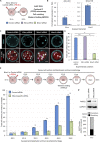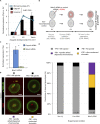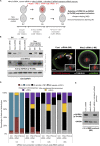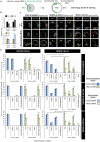Wwc2 Is a Novel Cell Division Regulator During Preimplantation Mouse Embryo Lineage Formation and Oogenesis
- PMID: 33042987
- PMCID: PMC7527741
- DOI: 10.3389/fcell.2020.00857
Wwc2 Is a Novel Cell Division Regulator During Preimplantation Mouse Embryo Lineage Formation and Oogenesis
Abstract
Formation of the hatching mouse blastocyst marks the end of preimplantation development, whereby previous cell cleavages culminate in the formation of three distinct cell lineages (trophectoderm, primitive endoderm and epiblast). We report that dysregulated expression of Wwc2, a genetic paralog of Kibra/Wwc1 (a known activator of Hippo-signaling, a key pathway during preimplantation development), is specifically associated with cell autonomous deficits in embryo cell number and cell division abnormalities. Division phenotypes are also observed during mouse oocyte meiotic maturation, as Wwc2 dysregulation blocks progression to the stage of meiosis II metaphase (MII) arrest and is associated with spindle defects and failed Aurora-A kinase (AURKA) activation. Oocyte and embryo cell division defects, each occurring in the absence of centrosomes, are fully reversible by expression of recombinant HA-epitope tagged WWC2, restoring activated oocyte AURKA levels. Additionally, clonal embryonic dysregulation implicates Wwc2 in maintaining the pluripotent epiblast lineage. Thus, Wwc2 is a novel regulator of meiotic and early mitotic cell divisions, and mouse blastocyst cell fate.
Keywords: blastocyst cell number; cell division; cell lineage decision; cell-fate; oocyte maturation; preimplantation mouse embryo.
Copyright © 2020 Virnicchi, Bora, Gahurova, Šušor and Bruce.
Figures






Similar articles
-
TEAD4 regulates trophectoderm differentiation upstream of CDX2 in a GATA3-independent manner in the human preimplantation embryo.Hum Reprod. 2022 Jul 30;37(8):1760-1773. doi: 10.1093/humrep/deac138. Hum Reprod. 2022. PMID: 35700449
-
Protein regulator of cytokinesis 1 regulates chromosome dynamics and cytoplasmic division during mouse oocyte meiotic maturation and early embryonic development.FEBS J. 2020 Dec;287(23):5130-5147. doi: 10.1111/febs.15458. FEBS J. 2020. PMID: 32562308
-
BET proteins are essential for the specification and maintenance of the epiblast lineage in mouse preimplantation embryos.BMC Biol. 2022 Mar 9;20(1):64. doi: 10.1186/s12915-022-01251-0. BMC Biol. 2022. PMID: 35264162 Free PMC article.
-
Anatomy of a blastocyst: cell behaviors driving cell fate choice and morphogenesis in the early mouse embryo.Genesis. 2013 Apr;51(4):219-33. doi: 10.1002/dvg.22368. Epub 2013 Feb 25. Genesis. 2013. PMID: 23349011 Free PMC article. Review.
-
Oocyte maturation: gamete-somatic cells interactions, meiotic resumption, cytoskeletal dynamics and cytoplasmic reorganization.Hum Reprod Update. 2015 Jul-Aug;21(4):427-54. doi: 10.1093/humupd/dmv011. Epub 2015 Mar 4. Hum Reprod Update. 2015. PMID: 25744083 Review.
Cited by
-
Association analysis of polymorphisms in SLK, ARHGEF9, WWC2, GAB3, and FSHR genes with reproductive traits in different sheep breeds.Front Genet. 2024 Apr 12;15:1371872. doi: 10.3389/fgene.2024.1371872. eCollection 2024. Front Genet. 2024. PMID: 38680425 Free PMC article.
-
The Hippo pathway component Wwc2 is a key regulator of embryonic development and angiogenesis in mice.Cell Death Dis. 2021 Jan 22;12(1):117. doi: 10.1038/s41419-021-03409-0. Cell Death Dis. 2021. PMID: 33483469 Free PMC article.
-
Comparison of the somatic TADs and lampbrush chromomere-loop complexes in transcriptionally active prophase I oocytes.Chromosoma. 2022 Dec;131(4):207-223. doi: 10.1007/s00412-022-00780-5. Epub 2022 Aug 29. Chromosoma. 2022. PMID: 36031655
References
LinkOut - more resources
Full Text Sources
Miscellaneous

